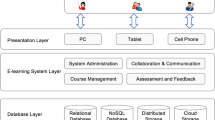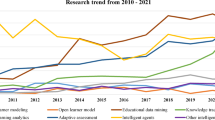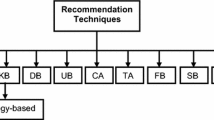Abstract
Rules in artificial intelligence are able to provide inference facilities for making effective decisions in information retrieval. In such a scenario, a keyword-based information retrieval systems use the keywords as indexes generated by Web crawlers without considering semantics. Moreover, many Web search engines perform re-ranking based on relevance feedback. However, the relevant documents in e-learning applications must be stored in local repositories and must be updated dynamically based on the level of the users. Therefore, it is necessary to have an information retrieval system which performs relevant information extraction and stores such relevant information dynamically in local e-learning repositories. In order to address these issues, a new information retrieval and local storage system is proposed in this paper by applying rules for making effective decisions in the storage and retrieval algorithms which are newly proposed in this paper. For this purpose, two new algorithms called intelligent rule-based relevant information retrieval algorithm with semantics and a secured information storage using semantic knowledge representation are proposed in this paper for effectively retrieving the e-learning contents from the Web on computer science subject and to store them in local repositories with semantic indexing. The major advantages of the proposed information retrieval system include increase in accuracy, reduction in retrieval time and effective storage in local repositories for further use.






Similar content being viewed by others
References
Page L, Brin S, Motwani R, Winograd T (1998) The PageRank citation ranking: bringing order to the web. Standford Digital Library Technologies Project
Bobed C, Mena E (2016) QueryGen: semantic interpretation of keyword queries over heterogeneous information systems. Inf Sci 329:412–433
Peng M, Gao B, Zhu J, Huang J, Yuan M, Li F (2016) High quality information extraction and query- oriented summarization for automatic query-reply in social network. Exp Syst Appl 44:92–101
Dou Z, Jiang Z, Sha 489 H, Wen J-R, Song R, (2016) Automatically mining facets for queries from their search results. IEEE Trans Knowl Data Eng 28(2):385–397
Muthurajkumar S, VijayalakshmiM, Ganapathy S, Kannan A (2015) Agent based intelligent approach for the malware detection for infected cloud data storage files. In: 2015 7th International Conference on Advanced Computing (ICoAC), IEEE Digital Library, pp 1–5
Ramesh LS, Ganapathy S, Bhuvaneshwari R, Kulothungan K, Pandiyaraju V, Arputharaj K (2015) Prediction of user interests for providing relevant information using relevance feedback and re-ranking. Int J Intell Inf Technol (IJIIT) 11(4):55–71
Deborah LJ, Baskaran R, Kannan A (2011) Ontology construction using computational linguistics for e-learning. In: Visual Informatics: Sustaining Research and Innovations, pp 50–63
Oproiu GC (2015) A study about using e-learning platform (moodle) in university teaching process. Proc Soc Behav Sci 180:426–432
Lai H, Wang M, Wang H (2010) Intelligent agent-based e-learning system for adaptive learning. In: Organizational Efficiency Through Intelligent Information Technologies, Chapter 9, IGI Global Publisher, Pennsylvania, pp 145–158 7
Gilman E, Milara IS, Cortes M, Riekki J (2015) Towards user support in ubiquitous learning systems. IEEE Trans Learn Technol 8(1):55–68
Rodrigues JJPC, Sabino FMR, Zhou L (2011) Enhancing e-learning experience with online social networks. IET Commun 5(8):1147–1154
Orriols-Puig A, Casillas J, Bernadó-Mansilla E (2009) Fuzzy-UCS: a Michigan-style learning fuzzy- classifier system for supervised learning. IEEE Trans Evol Comput 13(2):260–283
Klasnja-MilicevicA Vesin B, Mirjana I, Budimac Z (2011) E-learning personalization based on hybrid recommendation strategy and learning style identification. Comput Educ 56:885–899
Blot G, Saurel P (2014) Pattern discovery in e-learning courses: a time based approach. In: IEEE International Conference on Control, Decision and Information Technologies, pp 646–651
Wu Y, Wei F, Liu S, Au N, CuiW Zhou H, Qu H (2010) Opinionseer: interactive visualization of hotel customer feedback. IEEE Trans Visual Comput Graphics 16(6):1109–1118
QiaoaD, Zhangb J,WeiaQ, ChenaG(2017) Finding competitive keywords fromquery logs to enhance search engine advertising. Inf Manag 54:531–543
Chrysafiadi K, Virvou M (2015) Fuzzy logic for adaptive instruction in an e-learning environment for computer programming. IEEE Trans Fuzzy Syst 23(1):164–177
Deborah LJ, Baskaran R, Kannan A (2012) Deontic logic based ontology alignment technique for e-learning. Int J Intell Inf Technol 8(3):56–72
Brinton CG, Chiang M, Jain S, Lam H, Liu Z, Wong FMF (2014) Learning about social learning in MOOCs: from statistical analysis to generative model. IEEE Trans Learn Technol 7(4):346–359
Yang J, Huang ZX, Gao YX, Liu HT (2014) Dynamic learning style prediction method based on a pattern recognition technique. IEEE Trans Learn Technol 7(2):165–177
Dodero JM, Palomo-Duarte M, Ruiz-Rube I, Ribón IT, Mota JM, Balderas A (2015) Learning technologies and semantic Integration of learning Resources. IEEE-RITA 10(1):11–16
Ganapathy S, Kulothungan K, Muthurajkumar S, Vijayalakshmi M, Yogesh P, Kannan A (2013) Intelligent feature selection and classification techniques for intrusion detection in networks: a survey. EURASIP J Wirel Commun Netw 271(1):1–16
Su Q, Xu X, Guo H, Guo Z, Wu X, Zhang X, Swen B, Su Z (2008) Hidden sentiment association in Chinese web opinion mining. In: Proceedings of the 17th International Conference World Wide Web, pp 959–968
Blei DM, Ng AY, Jordan MI (2003) Latent Dirichlet allocation. J. Mach. Learn. Res. 3:993–1022
Yuvarani M, Iyengar NCSN, Kannan A (2006) LSCrawler: a framework for an enhanced focused web crawler based on link semantics. In: Proceedings of the 2006 IEEE/WIC/ACM International Conference on Web Intelligence, pp 794–800
Senthilnayaki B, Venkatalakshmi K, Kannan A (2015) An ontology based framework for intelligent web based e-learning. Int J Intell Inf Technol (IJIIT) 11(2):23–39
Chen H, Zimbra D (2010) AI and opinion mining. IEEE Intell Syst 25:74–80
Xia R, Xu F, Zong C, Li Q, Qi Y, Li T (2015) Dual sentiment analysis: considering two sides of one review. IEEE Trans Knowl Data Eng 27(8):2120–2133
Brito PQ, Soares C, Almeida S, Monte A, Byvoet M (2015) Customer segmentation in a large database of an online customized fashion business. Robot Comput Integr Manuf 36:93–100
Ahamed BB, Ramkumar T (2016) An intelligent web search framework for performing efficient retrieval of data. Comput Electr Eng 56:289–299
Seyfi A, Patel A, Júnior JC (2016) Empirical evaluation of the link and content-based focused Treasure-Crawler. Comput Stand Interfaces 44:54–62
Khalil S, Fakir M (2017) RCrawler: an R package for parallel web crawling and scraping. SoftwareX 6:98–106
Author information
Authors and Affiliations
Corresponding author
Rights and permissions
About this article
Cite this article
Alagarsamy, R., Sahaaya Arul Mary, S.A. Intelligent rule-based approach for effective information retrieval and dynamic storage in local repositories. J Supercomput 76, 3984–3998 (2020). https://doi.org/10.1007/s11227-017-2170-z
Published:
Issue Date:
DOI: https://doi.org/10.1007/s11227-017-2170-z




